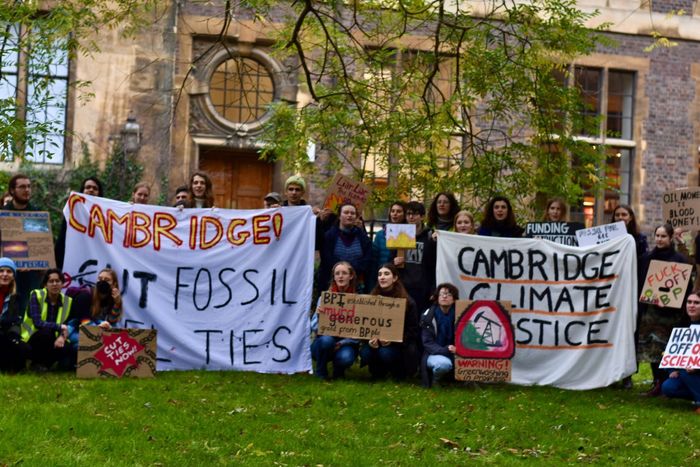What a return to Pride has reminded me about queer liberation
The colourful identity of Pride means more than music and rainbows – and it is up to us to embrace and protect its multiplicities

We are coming to the end of Pride season: photos are posted, glitter is safely stowed away, flags are back on the wall (or back in the drawer). There is something about the rainbow tint of summer that propels me through the year, and it’s not just the promise of sunshine after rain. No words can do justice to the unique atmosphere of freedom at a Pride march, where everyone is wearing whatever they want, dancing to cheesy pop singles and shouting liberatory slogans. To me, this is what the festivities are all about.
“Pride comes to embody the justice, however imperfect, that comes from using joy as protest”
Having come to this university thinking the city didn’t even have a Pride, it was a welcome addition to post-exam celebrations in June. Cambridge Pride is a small-scale affair compared to my local, thoroughly rain-soaked Bristol Pride. The official festival only came to the city in 2019 and, despite being cancelled during the pandemic, thankfully returned in 2022. Despite the festival-style prices that come with the atmosphere, getting to dance with my college mother to some amazing drag queens was one of the highlights of my first year.
However, Cambridge Pride affirmed more than just our fashion choices and familial ties. It was smaller and so reassuringly less corporate, with Anglia Ruskin University as its biggest sponsor, and boasted an impressive queer history exhibit that every student should take note of, beginning with the loss of so many Cambridge gay bars and pubs. As detailed there, many of these establishments were taken over by new management who wanted to get rid of queer associations, or unfortunately just went out of business. It turns out that the Anchor pub was once a hot-spot for queer discos, according to the queer audio trail of the city by English research fellow Diarmuid Hester.
“In that moment, it is enough just to exist”
Of course, Pride means so much more than just bars and clubs; one of its most important functions is to trailblaze diversity and access arrangements to protect all LGBTQ+ people. Only by making such spaces so open and (literally) free can we fully embody the need to help each other, as it is these events that can, and do, become prominent examples of how non-profit and volunteer events can be run. If we don’t make such spaces just as open for queer people of colour, or recognise the pressing need for trans pride, or promote accessibility for disabled and neurodivergent members of the community, then we are playing into the hands of those who somehow find our identities threatening. After all, the first Pride was a riot, and its early campaigns had trans women of colour at its forefront.
Having come out since attending my first Pride in the olden days of Year Ten, this access and vibrancy meant that much more, as I could finally connect internal feelings to an external community. I walked across town differently on that day. Equally, there shouldn’t be any pressure to have to come out to join in, or be conscious of starting out as an ally before coming out.
For the LGBTQ+ community, it can be easy to constantly be in mourning for those we have lost to homophobic and transphobic violence. Yet, it can be harder to channel that pain into something as loud and beautiful as Pride, in its fittingly multiplicitous identity as a festival and a protest.
If the idea of celebratory protest may seem contradictory, I think it is because the fluidity and brightness of Pride means that it is only growing as a celebration. It allows people to channel their anger while also just feeling comforted by the presence of others who understand this anger. Our voices (albeit singing 90s music very, very badly) are allowed to be part of a chorus.
Having found no shortage of fellow queer people here at Cambridge, I luckily have never felt that alone, or self-conscious of the cultural expression of queerness. The atmosphere of Pride for me acted as a reminder of what values we need to carry into these spaces – that of the power unleashed when a community is visible, and visibly welcoming.
When the news is full of hatred, I choose to remember all the local young people I saw at the park that day with their flags. Maybe they felt the same sense of relief that I did, as the weight of existing in the public sphere as a queer person is temporarily shared.
By the end of the day, Pride becomes the rainbow (which, I know, sounds incredibly cheesy). It reminds us that we can only come together as a community if we also honour those who fought for the right to celebrate so openly. And the brighter the rainbow, perhaps the easier it is to temporarily block out the storm.
 News / Caius mourns its tree-mendous loss23 December 2025
News / Caius mourns its tree-mendous loss23 December 2025 Comment / Yes, I’m brown – but I have more important things to say22 December 2025
Comment / Yes, I’m brown – but I have more important things to say22 December 2025 Interviews / Politics, your own way: Tilly Middlehurst on speaking out21 December 2025
Interviews / Politics, your own way: Tilly Middlehurst on speaking out21 December 2025 News / King appoints Peterhouse chaplain to Westminster Abbey22 December 2025
News / King appoints Peterhouse chaplain to Westminster Abbey22 December 2025 News / Clare Hall spent over £500k opposing busway 24 December 2025
News / Clare Hall spent over £500k opposing busway 24 December 2025









